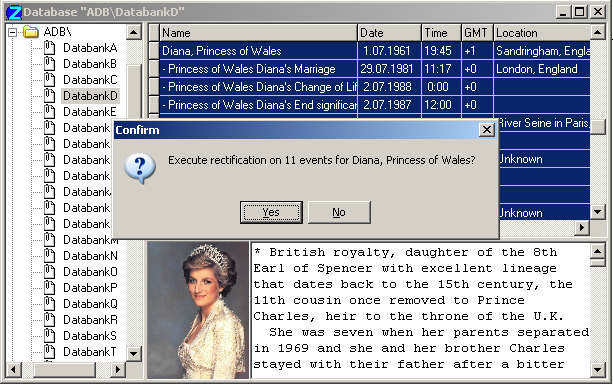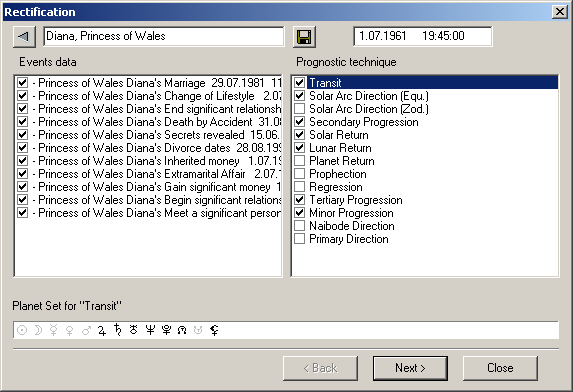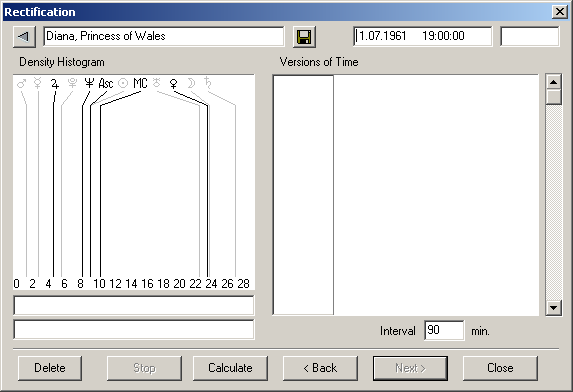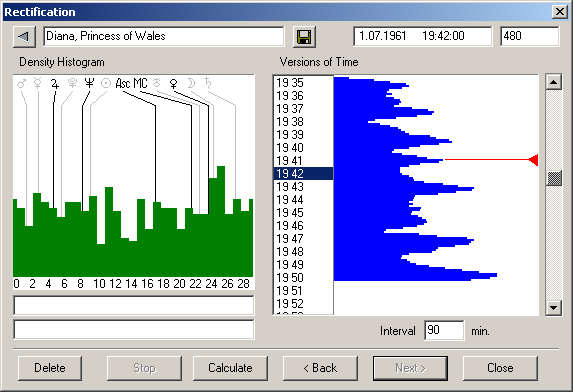Rectification - 'Condensations' method
Rectification is the deriving of an exact time for a nativity whose time of a birth is unknown. One approach to the problem is the astrological analysis of charts for events which have already occurred in the native's life. The technique described here is referred to as the 'condensations' method.
In outline the method is as follows:
- Some important events (the more, the better) in a native's life are chosen,
- For each event various prognostic charts
(transit, progression, direction, etc) are created,
- The prognostic charts are examined, and the numbers of hits of planets in each degree of
the external Zodiac circle are collated. Harmonics of 30 degrees are used.
This means that multiple 30° aspects of promissors (planets in the external circle)
to natal planets and points are considered,
- A histogram of the density of distribution of planets in this interval is calculated,
- It is expected that peaks in the histogram should coincide with the major points
of the natal chart (Asc, MC, the planetary rulers of the Asc and MC, and also, probably,
other planets). The prognostic charts for the event should demonstrate closer aspectual
concurrence than a chart for an arbitrary nearby moment of time,
- A native's time of birth is selected which best illustrates such a concurrence.
To see how this works, let's see ZET's Rectification Wizard in use on the example horoscope of Princess Diana.
1) Create the Database
The life events data is prepared for rectification as a set of records in the Database. It is possible to utilize a contiguous group of records for a native in one database page, or to create a separate database of them.
The first record of the group should be the native's birth data. This should be followed by the data of life events. The life event records must have a minus sign (-) as the first character in their Name field.
To start the Rectification Wizard, select the entire group of records by clicking the first record to select it then, while holding down the Shift key, clicking the last record so the whole group is highlighted (see screenshot). Then, right-click to display the Database window popup menu, and select "Rectify...":

Click "Yes" in the message box to confirm that you want to proceed.
2) Select the Prognostic Methods
In the Rectification Wizard's window it is possible to choose the desired prognostic techniques for the analysis from the list of available methods at right (the list comprises the available Dual Chart types). For each method, you can also select a set of planets to be taken into account. For example, for Transit one might elect to use only slow-moving planets, Jupiter thru Pluto; for directions - everything; for progressions - only the fast-moving planets, Sun thru Mars. To select a planet, click the mouse on its glyph in the Planet Set line containing the list of available planets and points.
To include the Asc and MC in the list of moving points, these need to be defined as the corresponding Arabic Parts with the formulae H1 and H10 respectively.

Click the "Next" button when you are ready to proceed.
3) Set the rectification interval
The sourced time of birth is 19:45. Let's explore the range +-45 minutes around this value, i.e. set the start time for searching as 19:00, and the interval as 90 minutes.

Click the "Calculate" button...
4) Create the Histogram of Hit-Density
Clicking the "Calculate" button executes the analysis. It may be necessary to wait a few minutes until the histogram-growing activities on the panel have ceased. The date/time entryfield at the top of the window will contain the final search time.

The left pane contains a hit-Density Histogram created for one point in time. Symbols for the natal planets, Asc and MC are displayed at the top of the histogram, their exact positions being marked by vertical lines. Asc, MC and their rulers are colored black, the other planets are light gray.
This histogram is examined by the Wizard to calculate how closely sensitive natal points coincide with the peaks of the graph (the coincidence factor).
The right pane is a diagram of the coincidence factor history, i.e. charting the dependence of the factor on alternative candidate birth times. The peaks of this diagram show the moments in time when the coincidence factor is maximal.
Select the peak nearest to the source time using the scroll-bar at right of the pane - this will be 19:42. The red index cursor can also be positioned by clicking in the list of times at left. For any time, the coincidence factor is displayed at top-right of the window.
The Condensations method of rectification is but one of several auxiliary tools for the astrologer - but in the final analysis, it does not follow to think of the data derived with it as true.
An alternative rectification method available in ZET is Trutina Hermetis.